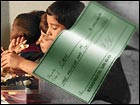|
Child tax credit expanded
|
 |
February 13, 2002: 9:50 a.m. ET
Kiddie tax credit for families with children under age 17 has been expanded.
By Gary Klott
|
CHICAGO (Tribune Media) - Parents will have their younger children to thank this tax season for some new tax relief.
The child tax credit for families with children under age 17 has been expanded. And the investment income of younger children will be taxed a bit less harshly.
Tens of millions of parents will benefit from the increase in the child tax credit. The Tax Relief Act of 2001 increased the maximum credit from $500 to $600 per child under 17 effective for 2001 income tax returns.
In addition, more lower-income parents will be able to reap benefit from the credit. In the past, the credit was generally "nonrefundable," which meant it could be used only to offset income taxes owed. As a result, many lower-income parents didn't get much, if any, benefit from the credit. An accommodation was made only for parents with three or more children.
Beginning with 2001 returns, many lower-income parents will get to benefit from the credit, even if they have fewer than three children. As a general rule, the child credit will be refundable to the extent of 10 percent of the parent's earned income in excess of $10,000.
If your earned income doesn't exceed $10,000, you may still get a break if you have three or more children who qualify for the credit.
While the new law relaxed the eligibility requirements for lower-income families, the credit remains elusive for higher-income parents.
As in the past, the benefit of the credit begins to phase out for married couples with "adjusted gross incomes" above $110,000 and single parents with incomes above $75,000. President Bush had sought an increase in the phase-out thresholds. But Congress didn't adopt the proposal.
Common source of errors
The child credit has been one of the most common sources of errors on tax returns since its inception several years ago. The credit is likely to be even more susceptible to error this tax season because of the new law changes for lower-income families.
When claiming the credit, be sure to follow the IRS tax form instructions carefully. To figure the credit, most taxpayers only need to fill out a five-line worksheet inside the IRS instruction booklet. But some parents, including higher-income taxpayers, are directed to use Publication 972, "Child Tax Credit." And lower-income parents need to fill out both a worksheet and Form 8812, "Additional Child Tax Credit."
Form 8812 has become longer and more complicated because of the tax law change for lower-income families. Parents may also be confused by the form's title. The "Additional Child Tax Credit" is a misnomer because it doesn't actually provide a credit in addition to the child tax credit. Rather, the "additional credit" is what enables lower-income parents to reap a benefit from the credit.
Kiddie tax
The investment income of children under age 14 has long been subject to special tax treatment to prevent higher-bracket parents from transferring a lot of investments to their younger sons and daughters just to save on taxes.
The amount of investment income a child under 14 can earn before it becomes subject to tax at their parent's rate has increased to $1,500 on 2001 returns, from $1,400 in 2000.
Most parents have a couple options for reporting interest and dividend income for a child under 14. You can fill out a separate return for the child. Or you can include the child's income on your own return and attach Form 8814.
In either case, the first $750 of the child's investment income will be tax-free and the next $750 will generally be taxed at the child's 10 percent tax rate. (The 10 percent rate is incorporated in Form 8814. But if you're filing a separate return for the child, you'll need to use the special "Tax Computation Worksheet for Certain Dependents" in the IRS instruction booklets to get the benefit of the new law's reduction in the bottom rate from 15 percent to 10 percent.) Additional income is taxed at the parents' rate, which will often be a lot higher than the child's rate.
Including the child's income on your own return will save you the bother of filling out a separate return for your child. But the shortcut can often result in a higher tax bill for the family.
That's because including the child's income on your return will increase your adjusted gross income. And that can cause you to lose some tax benefits. The size of certain tax deductions, such as those for medical and "miscellaneous" itemized expenses, is affected by adjusted gross income. In addition, many tax benefits -- including the child tax credit, IRAs and various college tax breaks -- are phased out for taxpayers with adjusted gross incomes above certain levels.
Even so, if you're having your return prepared by an accountant or some other tax professional, filing a separate return for the child may not be worthwhile. "The problem is that preparing the form professionally might cost you more than the potential tax savings," said David Rhine, regional director of family wealth planning at Sagemark Consulting, a financial planning firm in Rochelle Park, N.J. So don't insist on a separate return before you find out whether the fee will wipe out the tax advantage. 
|
|
|
|
|
|

|

